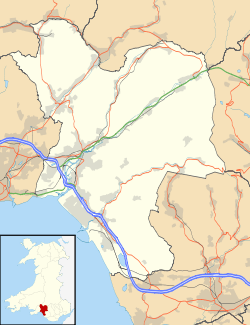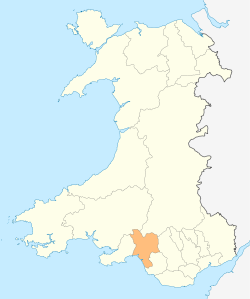Ystalyfera
| Ystalyfera | |
.jpg) Ystalyfera from Y Farteg |
|
 Ystalyfera |
|
| Population | 3,019 (2011 census) [1] |
|---|---|
| OS grid reference | SN767089 |
| Principal area | Neath Port Talbot |
| Ceremonial county | West Glamorgan |
| Country | Wales |
| Sovereign state | United Kingdom |
| Post town | SWANSEA |
| Postcode district | SA9 |
| Dialling code | 01639 |
| Police | South Wales |
| Fire | Mid and West Wales |
| Ambulance | Welsh |
| EU Parliament | Wales |
| UK Parliament | Neath |
| Welsh Assembly | Neath |
| Councillors | Alun Llewelyn (Plaid Cymru) |
|
|
Coordinates: 51°45′50″N 3°47′10″W / 51.764°N 3.786°W

Ystalyfera is a former industrial village in the upper Swansea Valley, on the River Tawe, about 13 miles (21 km) north-east of Swansea. It is an electoral ward and a community in the unitary authority of Neath Port Talbot, Wales, comprising a resident population of just over 3,000 people, approximately 60% of whom speak Welsh.[2]
National Cycle Route 43 passes though the village.
History
The history of Ystalyfera begins with a small farming family who shared the land. This is reflected in the village's name, composed from the Welsh words, Ynys (meaning island), tall, (meaning tall) and Berran (A Composite of Ber and Rhan, which indicates a land-share). A short piece of shared land (probably between agricultural labourers). The history of the name can be seen as it evolved through the ages: -
- 1582 Ynys Tal y Veran
- 1604 Tir Ynystalverran
- 1797 Stalyfera Issa, Ycha, Genol
- 1831 Ystalyfera
Ystalyfera grew as a village with the advent of coal mining and iron working, which were a huge part of everyday life in the local communities of the Swansea Valley (Welsh: Cwmtawe).
In 1838 a furnace was built by James Palmer Budd at Ystalyfera and from this grew the iron and tinplate works which by 1863 was described as 'the largest tinplate manufactory in the world'. A new cold-blast process was successfully introduced here and, despite some early crises, the works prospered. By the mid-1850s there were forty furnaces for puddling and balling in operation and sixteen tin mills and houses. The output of iron increased from the 4,893 tons of 1843 to 29,828 tons in 1858. The works continued to grow during the 1860s and reached peak production in 1872 with the sale of 182,000 boxes of tinplate.
By this time, however, the years of prosperity were numbered. The 1870s witnessed little further addition to the plant of the works. Steel had now come to challenge iron on a larger scale, new methods of production demanded the energy, technical skill and capital which the ageing J. P. Budd at Ystalyfera could not supply. The works continued to operate during the eighteen seventies, but with Budd's death in 1880 the end was in sight. By this time the works were incurring heavy losses and late in 1885 the works finally closed. For more than forty years the works had been the colossus of the district and, more than anything else, had been responsible for the transformation of the latter's economic basis and social structure. Less significant in their contribution were the two ironworks, at Pontardawe and Brynamman, though both became substantial producers of tinplate from the 1860s.
The expansion in iron production inevitably created a heavy demand for local coal. The middle decades of the 19th century saw the expansion of existing mines and the sinking of new ones in the parish and the neighbouring districts.
With the closure of the iron works and later the coalmines, Ystalyfera suffered very heavily on the economic front. Through the 20th century, the village rebuilt and redefined its role. At present, there are various small businesses that run in the village, though most of the village's inhabitants commute to nearby Swansea or Neath to work.
Present
The village has Welsh language schools at both primary school and comprehensive school level. The Wern (English: Alder) Primary School, which was established at the end of the 19th Century and Ysgol Gyfun Ystalyfera, the latter having consistently good examination results. These schools reflect the high proportion of Welsh speakers in the area.
Ystalyfera is home to Ystalyfera RFC – a rugby union club, which is an integral part of the village – and a cricket team. The village was home to two cinemas, as well as one just outside the boundary, which were all later demolished.
Ystalyfera is also the home to the Wern Fawr public house, and its famed Bryncelyn Brewery. The Brewery on site produced the Champion Beer of Wales in 2002/3 and 2003/4, coming 3rd in 2004/5. All of the beers produced have a Buddy Holly theme.
Population breakdown
Population density (People / sq mi) 2.8 (24.9 for UK) (Females / male) 1.07 (1.05 for UK) Average commute 12.03 miles (8.73 miles for UK) Average age 41 (39 for UK) Home ownership 12% (16.9% for UK) Student population 2% (4.4% for UK) People in good health 58% (69% for UK) People in bad health 42% (53% for UK)
Government and politics
The electoral ward of Ystalyfera is a division of Neath Port Talbot county borough and consists of some or all of the following settlements: Ystalyfera and Gurnos in the parliamentary constituency of Neath. The ward consists of a dense settlement to the east and north around the A4067 road in the Swansea Valley. An area of woodland lies to the west and the rest of the ward consists of open moorland with a few farms.
Ystalyfera is bounded by the wards of Cwmtwrch and of Powys to the northeast; Ystradgynlais Town (Ynyscedwyn ward), Powys to the east; Rhos to the southeast; Godre'r Graig to the south; Pontardawe to the west; and Cwmllynfell to the northwest.
In the 2012 local council elections, the electorate turnout was 44.38%. The results were:
| Candidate | Party | Votes | Status |
|---|---|---|---|
| Alun Llewelyn | Plaid Cymru | 591 | Plaid Cymru hold |
| Noir James | Labour | 422 |
Community Archives Wales
Ystalyfera Heritage Society is a well-established local history group based in Ystalyfera Development Trust. The group also holds larger meetings at the British Legion Club in Ystalyfera. Members of the group have a great deal of local knowledge which they are keen to share and the society has gathered a wonderful collection of photographs. The group's aim is to encourage and promote an interest and awareness of all aspects of local heritage and to make their collection available to the local community and to the wider community on the World Wide Web. With this in mind they joined the Community Archives Wales project in 2008.
References
- ↑ "Community population 2011". Retrieved 12 April 2015.
- ↑ "Lead view table". Office for National Statistics. 18 November 2004. Retrieved 5 July 2010.
External links
| |||||||||||||||||||||||||||||
| ||||||||||
